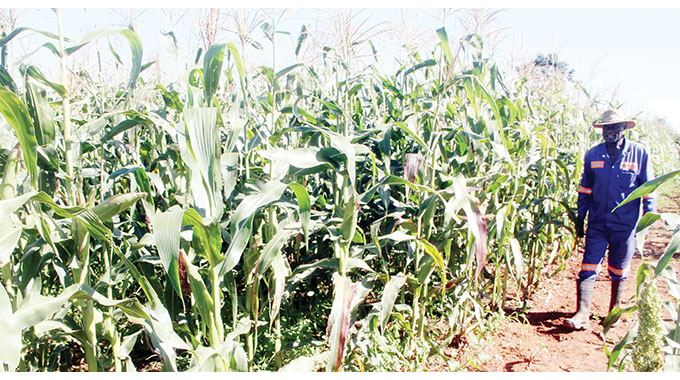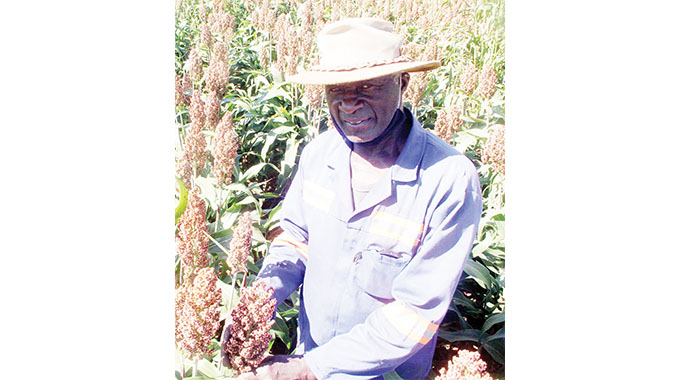80-year-old Intwasa farmer revels in success

Mashudu Netsianda, Senior Reporter
WITH his face partly obscured by tall maize plants in his field, 80-year-old Shadrack Tshuma could not hide his excitement as he showed off his crop that is already promising to yield a productive harvest under the Government sponsored Intwasa/Pfumvudza programme.
When Government introduced the new farming concept last year, Mr Tshuma, who used to rely on oxen for draught power, was initially cynical.
It took a countless number of visits to his home by Agritex officers to try and convince him to adopt conservation agriculture.
Today, the senior citizen has become a role model to his neighbours who were equally skeptical about adopting the Intwasa farming model.
He has made a great difference by emerging as a highly successful farmer now anticipating a bumper harvest of maize, sorghum and sunflower. When Government introduced Intwasa in March last year, the aim was to maximise productivity per unit area, even during drought periods, to ensure household and national food and nutritional security.
Intwasa involves the utilisation of small pieces of land and applying the correct agronomic practices for higher returns. The approach can be used in marginal areas and still give high yields.
A Chronicle news crew yesterday visited Mr Tshuma’s plot in Upper Rangemore in Umguza district in Matabeleland North to share his Intwasa success story.

Mr Shadrack Tshuma in his fields
“I started Intwasa this year and all along I had no interest in it because I have oxen to plough, but the agricultural extension officers kept visiting to explain about the concept until I eventually decided to give it a try,” he said.
“I am so proud of this Intwasa and I wish Government had introduced this concept way back. Sadly, in the past some farmers benefitting from the Presidential Input Scheme would opt to sell inputs instead, but I am glad we now perceive things differently and thanks to Intwasa.”
Mr Tshuma has managed to perfect the art of conservation agriculture after receiving support and extensive training from Agritex officers who have been working with farmers in Umguza district to increase the uptake of conservation agriculture.
“I have actually perfected my skills in Intwasa through training I got from our local agricultural extension officers. In fact, you don’t need expensive fertilisers and other inputs as conservation agriculture is handy and helps us to use local resources to boost our yields at low cost,” he said.
“As a farmer, I have embraced Intwasa or Pfumvudza farming concept because it increases yields while protecting fields from erosion, improving soil quality and mitigating the effects of drought. I urge farmers to adopt this concept so that we boost food security at household level.”
Mr Tshuma, who retired from formal employment in 2006, noted that some farmers had vast tracts of land with no meaningful output.
“All my children are grown ups and they have their families. I stay with my wife and obviously with this bumper harvest in sight, there is bound to be a surplus, which I will take to the Grain Marketing Board (GMB). I am looking forward to taking at least 30 tonnes of maize from Intwasa programme,” he said.
Mr Tshuma is facing challenges of thieves straying into his field and stealing green mealies.
In 2019, he lost 24 goats to thieves.
According to agriculture experts, Intwasa ensures food self-sufficiency.

An average family of four to six requires a bucket of maize every week and with Intwasa they can produce food to last them a whole year on a small piece of land.
“An average of about four to six members consumes a bucket of maize (20 kilogrammes of maize-meal) a week and if you use the potholing method you need 28 holes in which you sow two seed units per hole, you will get a total of 56 cobs and that is enough for one week,” said Ms Nozinhle Nyoni, a local agricultural extension officer.
Each week the family can feed from 28 holes and with the 52 rows yielding an average of one tonne, while a family of four to six consumes about half a tonne, food security is guaranteed.
It is therefore possible to save half a tonne of maize, which can be sold.
Ms Nyoni said by using the Intwasa concept, a farmer can also irrigate crops using a bucket and get a bumper harvest as opposed to planting maize on a large area without adequate resources and end up getting one bucket or less per hectare. — @mashnets











Comments